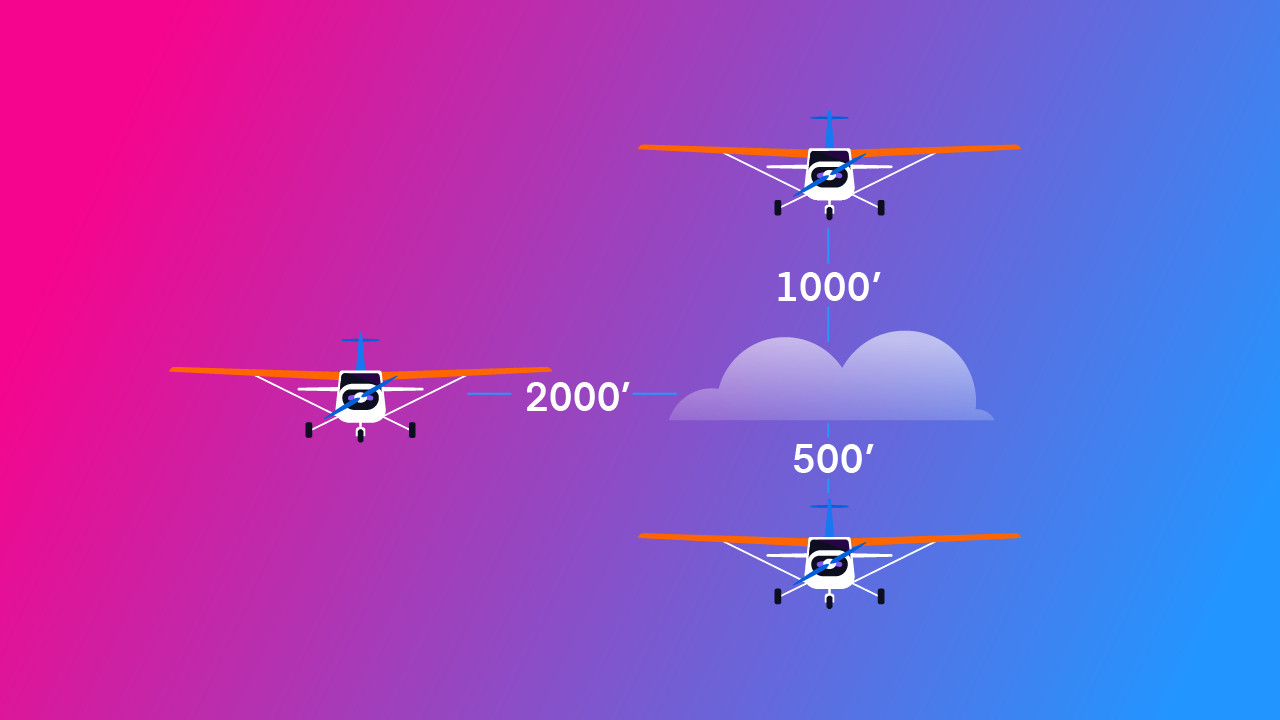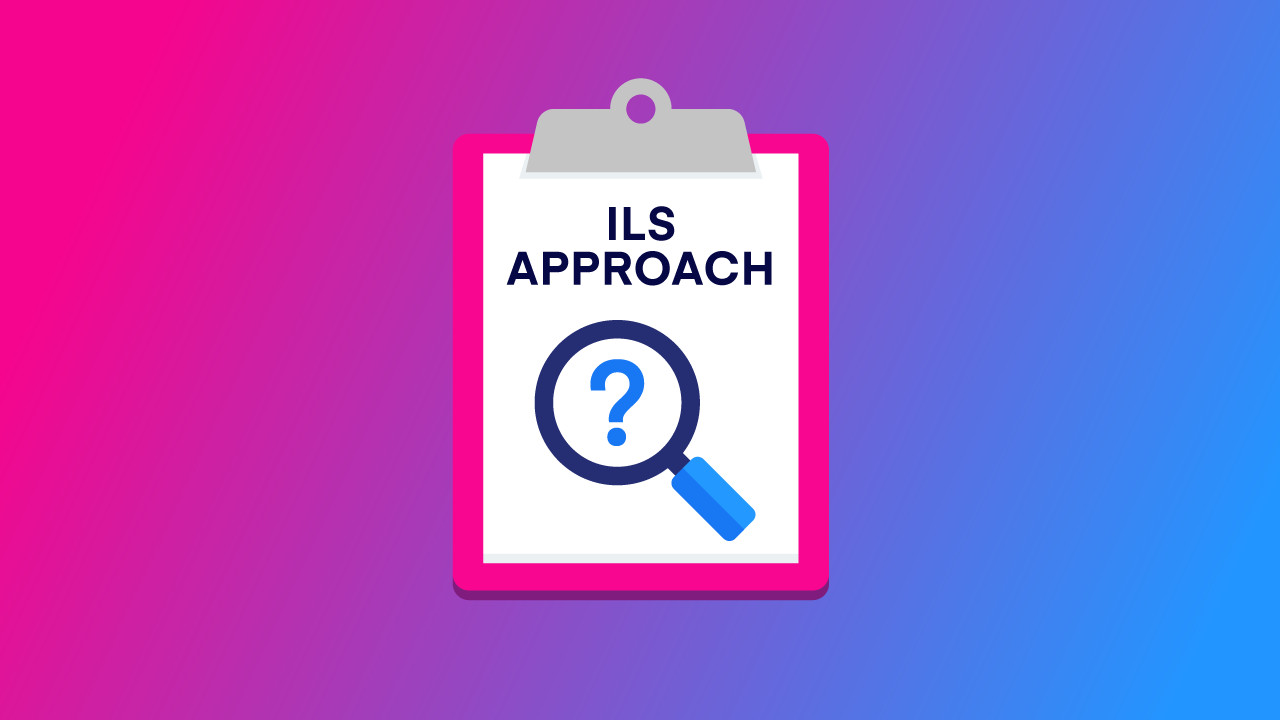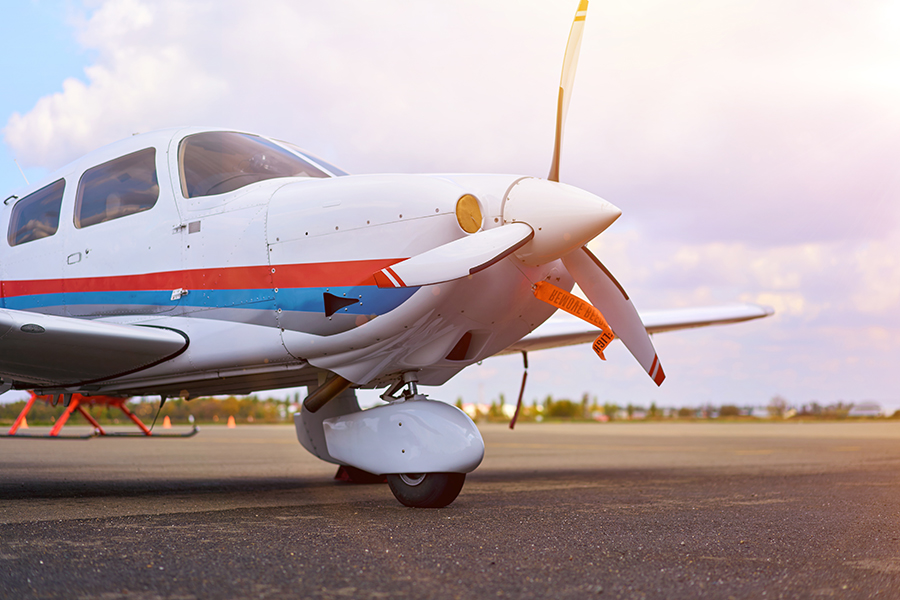-
Key Takeaways
-
What Are Weather Minimums for Pilots?
-
What are the Weather Minimums for VFR Flight?
-
Remembering Pilot Weather Minimums – Some Hints and Tips
- “C-D-G-3” + 152
- Remember Exceptions
- Clear of Cloud
-
What Determines the Weather Minimums for Pilots? (And Why it Changes)
- Class of Airspace
- Altitude
- Time of Day
-
Can a VFR Pilot Fly Above Clouds?
-
Can Airplanes Fly in Rain?
-
What Other Types of Minima are there in Aviation?
- Wind Minima
- Temperature Minima
- Personal Minima for Pilots
-
Conclusion
As a private pilot, most of your flying will follow the principle of ‘see and avoid’ concerning terrain and other traffic.
However, if you can’t see it, you can’t avoid it! Luckily, there are weather minimums for pilots to ensure you always have good visibility.
Today, we’ll discuss the different types of minimums for private pilots and explain, in simple terms, a few things you’ll need to consider before getting airborne.
Key Takeaways
- Weather minimums vary by airspace class, altitude, and time of day.
- “152” is a helpful shortcut for remembering VFR cloud clearance rules.
- Class E above 10,000 ft and Class G below 1,200 ft have special rules.
- Personal weather minimums improve safety, especially for newer pilots.
What Are Weather Minimums for Pilots?
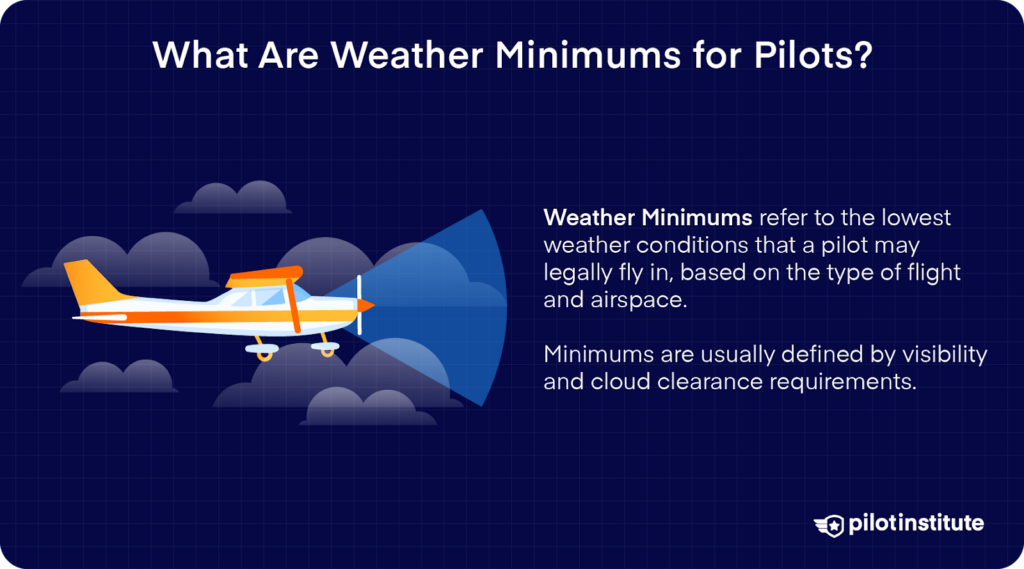
Weather minimums are limits given to pilots relating to visibility and cloud cover. Generally, it allows pilots to fly using visual flight rules, looking out the window to assess their own separation from other air traffic and terrain. If the weather is below the minimum, this goal is much harder.
However.
Understanding weather minima grows a little more complex, as it can change based on various factors. Such as:
- The type of airspace.
- Your altitude.
- The time of day.
- Your own personal comfort level.
There are also two parts to the weather minimums for pilots.
Two?
You bet!
Not only do pilots have to ensure that in-flight visibility is suitable, but we also have to ensure that we remain the correct vertical distance away from the cloud.
At first glance, it might sound like a lot to learn, but don’t worry. By the end of this guide, you’ll have a great grasp of the weather minima for pilots!
Let’s go into some more detail.
What are the Weather Minimums for VFR Flight?
First things first, let’s take a look at the minima itself. Here’s a quick table detailing the weather minima for airplane pilots, according to 14 CFR 91.155.
| Airspace Class | Minimum Visibility | Distance from Clouds |
| A | • IFR only | • IFR only |
| B | • 3 statute miles | • Clear of cloud |
| C | • 3 statute miles | • 500 ft below• 1000 ft above • 2000 ft horizontally |
| D | • 3 statute miles | • 500 ft below• 1000 ft above• 2000 ft horizontally |
| E (above 10,000 ft MSL) | • 5 statute miles | • 1000 ft below • 1000 ft above • 1 mile horizontally |
| E (below 10,000 ft MSL) | • 3 statute miles | • 1000 ft above• 500 ft below• 2000 ft horizontally |
| G ( Day, above 1,200 ft MSL) | • 1 statute mile | • 500 ft below• 1000 ft above• 2000 ft horizontally |
| G (Night, above 1,200 ft MSL) | • 3 Statute miles | • 500 ft below• 1000 ft above• 2000 ft horizontally |
| G (Day, below 1,200 ft MSL) | • 1 statute mile | • Clear of cloud |
| G (Night, below 1,200 ft MSL) | • 3 Statute miles | • 500 ft below• 1000 ft above• 2000 ft horizontally |
If you are daunted, don’t be.
There are all sorts of techniques pilots use to remember minima.
Notice above that there are a few common themes, and certain classes of airspace all share the same common minima? That’s a great place to start. From there, all you need to do is learn the ‘exceptions’.
There is another way, however.
Many people find a diagram to be most helpful.
There are a few out there. A Koji triangle, divided into the different airspace classes and minima, can be learned in minutes.
Check out some more of our hints and tips below for other ways to get to grips with weather minima.
Remembering Pilot Weather Minimums – Some Hints and Tips
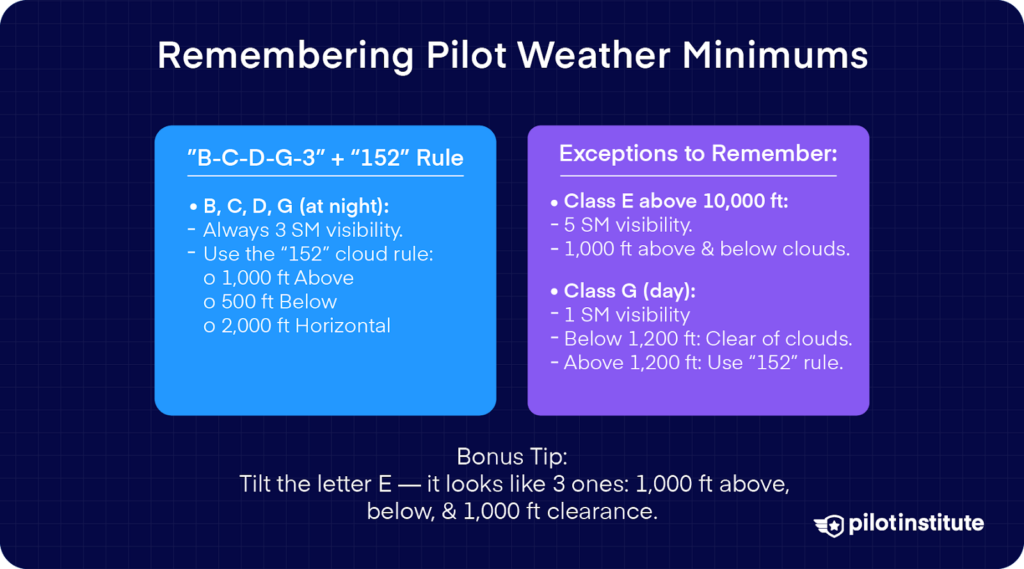
So, you’ve studied the above table, and it just isn’t going in?
No problem, we’ve got you.
There are plenty of patterns and ways to remember minima.
Here are some of our favorite techniques:
“C-D-G-3” + 152
Ever heard of a Cessna 152? Chances are, if you are a student pilot, then you have. This will give you a great key to remembering some weather minima for pilots. We’ll explain in a moment.
Remember “B-C-D-G-3” (they all rhyme).
For Classes B, C, D, and G airspace (at night), The forward visibility are always 3 statute miles. So already, you’ve learned a decent chunk of the minima.
The “152” part relates to the vertical and horizontal clearance for the cloud.
- 1000 above
- 500 below
- 2000 horizontal.
The above vertical tolerances always apply to class C, D, and G airspace (at night).
Remember Exceptions
Learning the “152” acronym covers you for the vast majority of airspace weather minima. However, a few types don’t fit within this bracket (which is a shame).
However, by remembering the handful of airspace classes that are different, you can make life easy for yourself.
The exceptions to the above are as follows:
Class E Airspace above 10,000 ft:
- Visibility requirements increase to 5 statute miles (and this is the only airspace that has this requirement).
- You need 1000 ft of cloud clearance above and below your aircraft.
Bonus Tip: This is an easy one to remember. If you tip the ‘E’ onto its side, it looks like three number ‘1’s, giving you a great clue about the cloud clearance.
Class G Airspace During the Day:
During the day, Class G airspace is the least restrictive and only requires forward visibility of 1 statute mile.
Always. Independent of altitude.
However, the cloud layer criteria do change in class G airspace based on your altitude. Above 1200 ft, you can go with our “152” acronym relating to cloud clearance.
Below 1200 ft, you just need to keep clear of clouds.
Speaking of which…
Clear of Cloud
Only class B airspace and Class G have the ‘clear of cloud’ criteria during the day.
What Determines the Weather Minimums for Pilots? (And Why it Changes)

There are some significant variations in weather minimums.
It can be perplexing to student pilots. After all, the airplane flies the same regardless of imaginary airspace lines drawn on the map or the time of day, right?
True.
However, it is vital to understand why minima changes depending on different factors. Here are the three main areas that influence weather minimums for pilots.
Class of Airspace
The class of airspace you fly in has a significant effect on the weather minimums.
Why?
Look at the table above, and pay particular attention to Class E airspace. Notice anything about the in-flight visibility and the cloud base?
Both need to be greater when flying above 10,000 ft.
This is because, at these altitudes, you are more likely to encounter fast-moving traffic that may also be flying on instruments only. The increase in minima is to give you and the other aircraft more opportunity to maneuver and avoid.
Take a look at class B, C, and D airspace.
All are not quite as restrictive. This is because class B, C, and D airspace is controlled and normally situated around airports. If you are working on the principle of ‘see and avoid,’ this is great.
Why?
Being close to airports generally means that aircraft are flying at slower speeds. Moreover, there will normally be an air traffic controller keeping you separated. For that reason, you don’t need to see as far.
Altitude
You must be aware of a couple of altitude delineations when discussing pilot weather minimums.
They are:
- 1,200 ft above ground level.
- Above 10,000 above sea level.
The 10,000-foot boundary exists for similar reasons as described above. You’ll generally encounter faster traffic, and there is always the possibility of instrument traffic suddenly appearing in the clouds beneath or above you. So, better to give them a little room.
Below 1,200ft, you’ll notice a significant difference in class G airspace. Below this altitude, there is no set limit on your distance from the cloud. You simply have to ‘keep clear’.
This is because, when navigating using ground features, you may be unable to keep clear beneath the cloud by 500 ft and still be assured of terrain clearance.
Time of Day
It should be no surprise that things become harder to see at night. As a result, the minimum visibility has to be increased compared to the day.
We recommend learning more about how pilots ’see’ at night.
Can a VFR Pilot Fly Above Clouds?

A pilot can fly VFR above the clouds. It is vitally important to note that at no point should a VFR pilot enter the clouds. Furthermore, VFR pilots navigate using ground features, so you must be able to assess your position and remain clear of other aircraft.
Take a look at the class ‘G’ minima above. You’ll note that there is an allowance for a pilot to fly above a cloud, either by being clear of cloud during the day or 1000 ft above at night…
However.
Look at the minima for nighttime.
It is also important to note that you must maintain a horizontal separation of greater than 2000 ft.
Why is that so important?
Let’s say you are cruising along over the top. You get to your destination airport, and there is a ‘hole’ 1000 ft wide. You can just duck through and go for it, right?
No way! You wouldn’t be able to satisfy the horizontal weather minimum and would therefore be breaking the law!
Flying in clouds, sometimes even near them, can be a precarious business. On a ‘good weather day’ with fair weather cumulus, it can be exhilarating to be above the clouds. It is far better to cut your losses on overcast or marginal days and wait for better VFR conditions.
Can Airplanes Fly in Rain?
Airplanes can fly in the rain, even light aircraft. The main hazard presented by rain is a deterioration in visibility. The cumulative effect of raindrops in a rain shower can cause a significant reduction in forwarding visibility.
And there is another important point to bear in mind.
Even if the visibility in a rain shower is greater than the VFR minima, it can still be challenging to see outside the cockpit. Most light airplanes don’t have wipers, so the rivulets and water that collects on the cockpit canopy make it more difficult to see.
Watch this clip and check out the visibility before and after the pilot enters the rainstorm
What Other Types of Minima are there in Aviation?
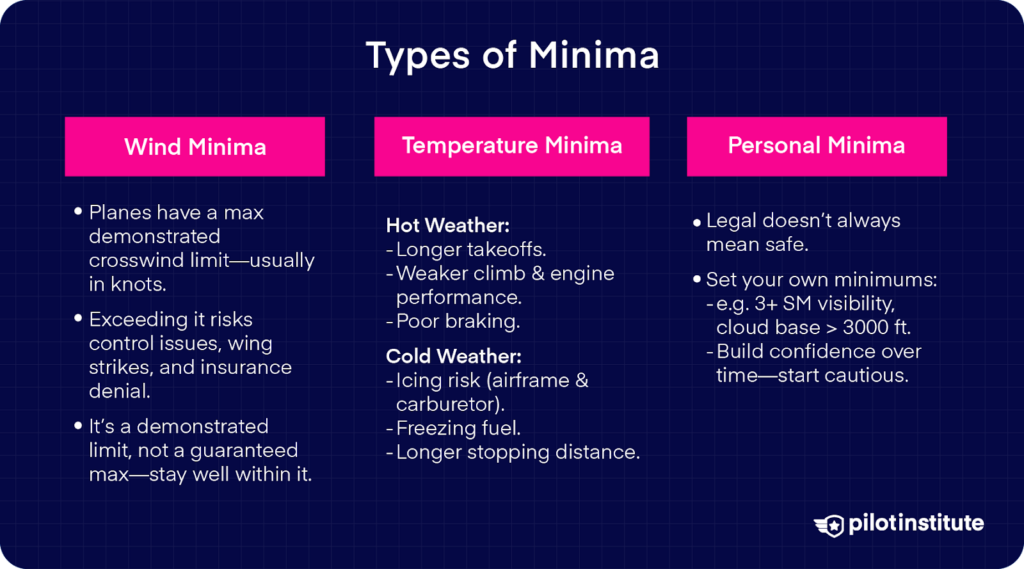
While the weather and is normally the overriding concern for most private pilots, there are a few other things that you need to be aware of.
Wind Minima
Airplanes fly at hundreds of miles an hour. So, the wind isn’t an issue?
Actually, this isn’t quite true.
While airplanes are pretty tough, there are limits on how strong wind they can fly in.
Particularly crosswinds.
Most airplane manufacturers will specify a maximum demonstrated crosswind limit. This is given in nautical miles per hour (or ‘knots, if you prefer) and details how much wind the airplane can safely handle from the side during takeoff and landing.
To counteract the wind when close to the ground, the pilot may have to apply a roll input to keep the airplane tracking straight. With too much roll input, the wing could contact the ground.
Airplane manufacturers don’t normally test an airplane all the way up to this occurring (test pilots don’t like crashing), hence the ‘demonstrated’ in the description in your airplane flight manual.
To attempt a landing or takeoff outside of these values is flirting with trouble. Damage and threats to flight safety aside, it will likely invalidate your airplane insurance if it is discovered you exceeded the wind minimum.
Temperature Minima
Airplanes fly as a result of the wings’ interaction with the air. The dynamic properties of the air change depending on temperature.
During hot weather, aircraft performance is reduced. Sometimes, in very hot climates, this can be significant. Pilots could expect to see:
- A longer takeoff run.
- Reduced climb performance.
- Reduced braking action on the runway.
- Decreased engine power.
- Increased stall speed.
Cold weather is better for airplane performance to a point. However, it brings its own hazards.
This can include:
- Airframe icing.
- Carburetor icing.
- Increased stopping distance.
- Fuel and other fluids freezing.
To name but a few. Some airplanes have temperature limits and minima, normally specified in the airplane flight manual.
Personal Minima for Pilots
Personal minima are something that is very much down to each individual pilot.
Let us ask you a question.
Do you always drive at the maximum speed limit?
No?
It is no different in aviation.
While the weather may legally satisfy the minimum, flying isn’t always a good idea. In the daytime (and as you’ll by now already know), class G airspace requires minimum visibility of only 1 mile.
If you think that’s a long way, think again.
At a ground speed of 120 knots, that only gives you a 30-second horizon to see what’s ahead. If flying in areas with hazards, such as high terrain, this isn’t ideal.
The good news?
By creating your own personal pilot minima, you can avoid becoming ‘trapped’ by weather.
You could create a rule for yourself to only fly with visibility greater than, say, 3 statute miles or with a cloud base greater than 3000 ft.
You’ll find that as you fly more, your confidence will increase. You may be able to fly closer to the published minima, but when you are just starting out, it is great airmanship to air on the side of caution.
Conclusion
Learning the weather minimums for pilots is actually quite easy. Once you know them, you’ll be able to apply them readily and be able to make a quick assessment on whether it is truly ‘flying weather’.
For more great guides and answers to aviation questions, visit our blog. Alternatively, why not give our free online pilots’ course a try and see how much more you could learn.
